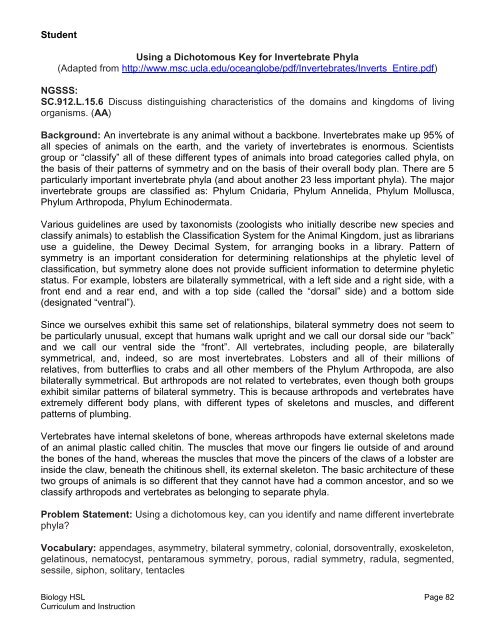Biology - HOT Science Lab
Biology - HOT Science Lab
Biology - HOT Science Lab
You also want an ePaper? Increase the reach of your titles
YUMPU automatically turns print PDFs into web optimized ePapers that Google loves.
Student<br />
Using a Dichotomous Key for Invertebrate Phyla<br />
(Adapted from http://www.msc.ucla.edu/oceanglobe/pdf/Invertebrates/Inverts_Entire.pdf)<br />
NGSSS:<br />
SC.912.L.15.6 Discuss distinguishing characteristics of the domains and kingdoms of living<br />
organisms. (AA)<br />
Background: An invertebrate is any animal without a backbone. Invertebrates make up 95% of<br />
all species of animals on the earth, and the variety of invertebrates is enormous. Scientists<br />
group or ―classify‖ all of these different types of animals into broad categories called phyla, on<br />
the basis of their patterns of symmetry and on the basis of their overall body plan. There are 5<br />
particularly important invertebrate phyla (and about another 23 less important phyla). The major<br />
invertebrate groups are classified as: Phylum Cnidaria, Phylum Annelida, Phylum Mollusca,<br />
Phylum Arthropoda, Phylum Echinodermata.<br />
Various guidelines are used by taxonomists (zoologists who initially describe new species and<br />
classify animals) to establish the Classification System for the Animal Kingdom, just as librarians<br />
use a guideline, the Dewey Decimal System, for arranging books in a library. Pattern of<br />
symmetry is an important consideration for determining relationships at the phyletic level of<br />
classification, but symmetry alone does not provide sufficient information to determine phyletic<br />
status. For example, lobsters are bilaterally symmetrical, with a left side and a right side, with a<br />
front end and a rear end, and with a top side (called the ―dorsal‖ side) and a bottom side<br />
(designated ―ventral‖).<br />
Since we ourselves exhibit this same set of relationships, bilateral symmetry does not seem to<br />
be particularly unusual, except that humans walk upright and we call our dorsal side our ―back‖<br />
and we call our ventral side the ―front‖. All vertebrates, including people, are bilaterally<br />
symmetrical, and, indeed, so are most invertebrates. Lobsters and all of their millions of<br />
relatives, from butterflies to crabs and all other members of the Phylum Arthropoda, are also<br />
bilaterally symmetrical. But arthropods are not related to vertebrates, even though both groups<br />
exhibit similar patterns of bilateral symmetry. This is because arthropods and vertebrates have<br />
extremely different body plans, with different types of skeletons and muscles, and different<br />
patterns of plumbing.<br />
Vertebrates have internal skeletons of bone, whereas arthropods have external skeletons made<br />
of an animal plastic called chitin. The muscles that move our fingers lie outside of and around<br />
the bones of the hand, whereas the muscles that move the pincers of the claws of a lobster are<br />
inside the claw, beneath the chitinous shell, its external skeleton. The basic architecture of these<br />
two groups of animals is so different that they cannot have had a common ancestor, and so we<br />
classify arthropods and vertebrates as belonging to separate phyla.<br />
Problem Statement: Using a dichotomous key, can you identify and name different invertebrate<br />
phyla<br />
Vocabulary: appendages, asymmetry, bilateral symmetry, colonial, dorsoventrally, exoskeleton,<br />
gelatinous, nematocyst, pentaramous symmetry, porous, radial symmetry, radula, segmented,<br />
sessile, siphon, solitary, tentacles<br />
<strong>Biology</strong> HSL Page 82<br />
Curriculum and Instruction

















